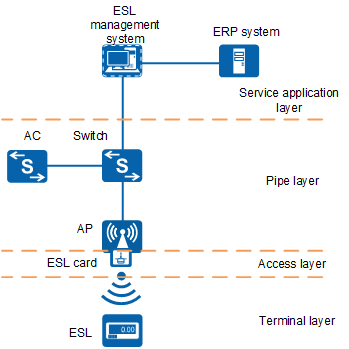Overview of the Smart Retail IoT Solution - ESL
Scenario Overview
- Manual label maintenance has high costs and low efficiency.
- Manual label maintenance is prone to errors, which may lead to customer complaints.
To address these problems, Huawei offers the Smart Retail-Electronic Shelf Label (ESL) Solution. In this solution, ESLs are used instead of printed labels, and ESL information is maintained and updated in a background ESL management system.
Solution Benefits
Reduces ESL maintenance and update costs, saves shelf label update costs, and increases business profits.
Implements automatic ESL management, and improves management and maintenance efficiency.
Minimizes the maintenance error rate and reduces customer complaints.
Reuses a WLAN as an ESL network, reducing the ESL network deployment and maintenance costs, and facilitating central network management by administrators.
Networking Architecture
Terminal layer
ESLs installed on shelves are deployed at this layer.
ESLs, typically made of electronic paper or liquid crystal displays (LCDs), display commodity information. ESLs with built-in radio modules automatically obtain ESL information over radios from the AP, and update information to be displayed.
Access layer
ESL cards are deployed at this layer.
An ESL card is a type of Internet of Things (IoT) cards used in the ESL Solution. ESL cards are used to receive and cache ESL update tasks delivered by the ESL management system.
Pipe layer
Network devices such as APs, ACs, and switches are deployed at this layer.
The pipe layer only forwards packets from ESLs and ensures interworking between the ESL cards and ESL management system, but does not parse or handle the packets. APs at the bottom of the pipe layer provide slots for ESL cards.
Service application layer
The Enterprise Resource Planning (ERP) system and ESL management system are deployed at this layer.
The ERP system is a business management software integrating physical resource management (logistics), human resources management (HR flows), and financial resource management (financial flows), and information resource management (information flows). In scenarios where ESLs are used, an ERP system is typically used to manage commodity prices.
An ESL management system consists of an ESL server and a system platform, and is interconnected with an ERP system to synchronize data from the ERP system and deliver ESL update tasks to ESL cards. The ESL server manages ESL cards, ESLs, and ESL update plans, and provides a graphical user interface (GUI).
Involved Products
Device |
Function |
Vendor |
|---|---|---|
AP |
It provides slots for ESL cards. |
Huawei Currently, only the AirEngine 5760-51, AirEngine 6760-X1, AirEngine 6760-X1E, AirEngine 8760-X1-PRO, AP4050DN-E and AP7060DN provide such slots. |
AC |
It manages and delivers configurations to APs, and works together with the APs. |
Huawei |
Switch |
It is used to build a networking structure and forward packet data on the network. |
Huawei |
ESL |
It is installed on a shelf to display commodity information. |
Century, Hanshow, or SES-imagotag Currently, the AirEngine 5760-51, AirEngine 6760-X1, AirEngine 6760-X1E, and AirEngine 8760-X1-PRO can work with only ESLs of SES-imagotag. |
ESL card |
It exchanges packets with ESLs, receives and caches ESL update tasks delivered by an ESL server, and delivers the tasks to ESLs for update. |
Century, Hanshow, or SES-imagotag Currently, the AirEngine 5760-51, AirEngine 6760-X1, AirEngine 6760-X1E, and AirEngine 8760-X1-PRO can work with only ESLs of SES-imagotag. |
ESL server |
It is interconnected with an ERP system to manage ESL cards and ESLs. In this solution, the ESL server is provided by Century. |
Century, Hanshow, or SES-imagotag Currently, the AirEngine 5760-51, AirEngine 6760-X1, AirEngine 6760-X1E, and AirEngine 8760-X1-PRO can work with only ESLs of SES-imagotag. |
Handheld scanner |
It is used to scan commodity codes and ESL IDs. Commodity codes and ESL IDs are associated automatically after being scanned. In this solution, handheld scanners are provided by Century. |
Century, Hanshow, or SES-imagotag Currently, the AirEngine 5760-51, AirEngine 6760-X1, AirEngine 6760-X1E, and AirEngine 8760-X1-PRO can work with only ESLs of SES-imagotag. |
ERP system |
It is used to manage commodity prices. |
Customer |
